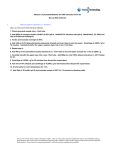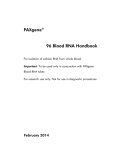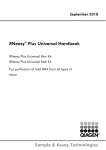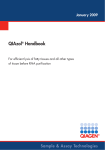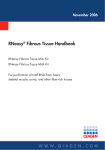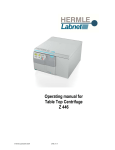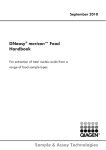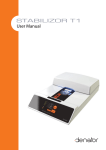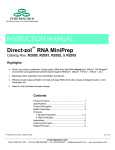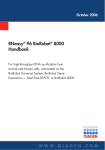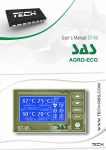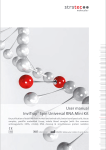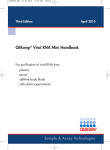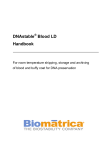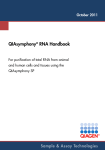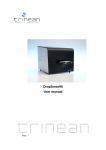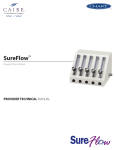Download DNeasy Plant Handbook - Biology Courses Server
Transcript
October 2012 DNeasy® Plant Handbook DNeasy Plant Mini Kit DNeasy Plant Maxi Kit For purification of total cellular DNA from plant cells and tissues, or fungi DNeasy 96 Plant Kit For high-throughput purification of DNA from plant tissue Sample & Assay Technologies QIAGEN Sample and Assay Technologies QIAGEN is the leading provider of innovative sample and assay technologies, enabling the isolation and detection of contents of any biological sample. Our advanced, high-quality products and services ensure success from sample to result. QIAGEN sets standards in: I I I I Purification of DNA, RNA, and proteins Nucleic acid and protein assays microRNA research and RNAi Automation of sample and assay technologies Our mission is to enable you to achieve outstanding success and breakthroughs. For more information, visit www.qiagen.com. Contents Kit Contents 4 Storage 5 Intended Use 6 Safety Information 6 Quality Control 6 Introduction 7 Principle and procedure 7 Description of protocols 11 Equipment and Reagents to Be Supplied by User 12 Important Notes 14 Collection and storage of starting material 14 Sample size 14 Disruption and homogenization using the TissueRuptor 15 Disruption and homogenization using the TissueLyser System 15 Centrifugation (DNeasy 96 procedures) 17 Lysate filtration with QIAshredder (DNeasy Mini and Maxi procedures) 19 Elution 19 DNA storage 21 Protocols Purification of Total DNA from Plant Tissue (Mini Protocol) 22 Purification of Total DNA from Plant Tissue (Maxi Protocol) 26 Purification of Total DNA from Fresh Plant Tissue (DNeasy 96 Protocol) 30 Purification of Total DNA from Frozen or Lyophilized Plant Tissue (DNeasy 96 Protocol) 35 Troubleshooting Guide 42 Appendix A: Determination of Yield, Purity, and Length of DNA 46 Appendix B: Recovery and Cleaning of Beads and S-Blocks 48 Ordering Information 49 DNeasy Plant Handbook 10/2012 3 Kit Contents DNeasy Plant Mini and Maxi Kits DNeasy Plant Kits Mini (50) Mini (250) Maxi (6) Maxi (24) 69104 69106 68161 68163 Number of preps 50 250 6 24 DNeasy Mini Spin Columns (colorless) 50 250 – – DNeasy Maxi Spin Columns (colorless) – – 6 24 QIAshredder Mini Spin Columns (lilac) 50 250 – – QIAshredder Maxi Spin Columns (lilac) – – 6 24 Collection Tubes (2 ml) 50 250 – – – – 6 24 40 ml 200 ml 40 ml 140 ml 20 ml 2 x 50 ml 18 ml 50 ml Catalog no. Collection Tubes (50 ml) Buffer AP1 Buffer P3 Buffer AW1 (concentrate)* 2 x 19 ml 151 ml 25 ml 151 ml Buffer AW2 (concentrate)† 17 ml 2 x 40 ml 26 ml 2 x 68 ml 2 x 12 ml 2 x 60 ml 15 ml 60 ml 220 µl 5 x 220 µl 110 µl 440 µl 1 1 1 1 † Buffer AE RNase A (100 mg/ml) Quick-Start Protocol * Contains a chaotropic salt. Not compatible with disinfectants containing bleach. See page 6 for safety information. † 4 Buffer AW1 and Buffer AW2 are supplied as concentrates. Add ethanol (96–100%) according to the bottle label before use to obtain a working solution. DNeasy Plant Handbook 10/2012 DNeasy 96 Plant Kit DNeasy 96 Plant Kit (6) Catalog no. 69181 Number of preps 6 x 96 DNeasy 96 Plates 6 S-Blocks* 2 Collection Microtubes, 1.2 ml (racked) Collection Microtube Caps Elution Microtubes RS (racked) and caps AirPore Tape Sheets 12 x 96 4 x (120 x 8) 6 x 96 5 x 25 Buffer AP1 2 x 140 ml Buffer P3 2 x 50 ml Buffer AW1 (concentrate) 151 ml Buffer AW2 (concentrate) 2 x 81 ml †‡ ‡ Buffer AE RNase A (100 mg/ml) Reagent DX 128 ml 2 x 440 µl 1 ml 96-Well-Plate Registers 6 Quick-Start Protocol 1 * Reusable; see Appendix B (page 48) for cleaning instructions. † Contains a chaotropic salt. Not compatible with disinfectants containing bleach. See page 6 for safety information. ‡ Buffer AW1 and Buffer AW2 are supplied as concentrates. Add ethanol (96–100%) according to the bottle label before use to obtain a working solution. Storage DNeasy Maxi spin columns should be stored dry at 2–8°C upon arrival and are stable for 1 year under these conditions. All other components of DNeasy Plant Kits, including RNase A stock solution, should be stored dry, at room temperature (15–25°C) and are stable for 1 year under these conditions. For storage longer than 1 year or if ambient temperatures often exceed 25°C, we recommend keeping the RNase A stock solution at 2–8°C. DNeasy Plant Handbook 10/2012 5 Intended Use DNeasy Plant Kits are intended for molecular biology applications. These products are not intended for the diagnosis, prevention, or treatment of a disease. All due care and attention should be exercised in the handling of the products. We recommend all users of QIAGEN® products to adhere to the NIH guidelines that have been developed for recombinant DNA experiments, or to other applicable guidelines. Safety Information When working with chemicals, always wear a suitable lab coat, disposable gloves, and protective goggles. For more information, please consult the appropriate safety data sheets (SDSs). These are available online in convenient and compact PDF format at www.qiagen.com/safety where you can find, view, and print the SDS for each QIAGEN kit and kit component. CAUTION: DO NOT add bleach or acidic solutions directly to waste containing Buffers AW1 and AL. Buffer AW1 contains guanidine hydrochloride, which can form highly reactive compounds when combined with bleach. If liquid containing this buffer is spilt, clean with suitable laboratory detergent and water. If the spilt liquid contains potentially infectious agents, clean the affected area first with laboratory detergent and water, and then with 1% (v/v) sodium hypochlorite. 24-hour emergency information Emergency medical information in English, French, and German can be obtained 24 hours a day from: Poison Information Center Mainz, Germany Tel: +49-6131-19240 Quality Control In accordance with QIAGEN’s ISO-certified Quality Management System, each lot of the DNeasy Plant Kits is tested against predetermined specifications to ensure consistent product quality. 6 DNeasy Plant Handbook 10/2012 Introduction DNeasy Plant Kits provide a fast and easy way to purify DNA from plant and fungal tissue. Up to 100 mg of tissue can be processed using the DNeasy Plant Mini Kit or up to 1 g of tissue using the DNeasy Plant Maxi Kit. The DNeasy 96 Kit is designed for high-throughput DNA purification from 50 mg plant tissue per well (for some plant tissues, up to 100 mg per well can be used). Easy-to-use DNeasy Plant procedures provide pure total DNA (genomic, mitochondrial, and chloroplast) for reliable PCR and Southern blotting in less than 1 hour (DNeasy Plant Mini Kit) or 2 hours (DNeasy Plant Maxi Kit or DNeasy 96 Plant Kit). Purification requires no phenol or chloroform extraction or alcohol precipitation, and involves minimal handling. This makes DNeasy Mini and Maxi Kits highly suited for simultaneous processing of multiple samples. For higher-throughput applications, the DNeasy 96 Plant Kit enables simultaneous processing of 96 or 192 samples. Purified DNA is eluted in low-salt buffer or water, ready for use in downstream applications. DNA purified using DNeasy Plant Kits is up to 40 kb in size, with fragments of 20–25 kb predominating. DNA of this length denatures completely in PCR and shows the highest amplification efficiency. Purified DNA has an A260/A280 ratio of 1.7–1.9, indicating high purity of the DNA. The DNeasy membrane ensures complete removal of all inhibitors of PCR and other enzymatic reactions. DNA purified using DNeasy Plant Kits is highly suited for use in all downstream applications, including PCR, RAPD analysis, AFLP analysis, RFLP analysis, Southern blotting, microsatellite analysis, SNP genotyping, and quantitative, real-time PCR. Use of the TissueRuptor® or the TissueLyser, for rapid and convenient disruption of plant tissue samples, is recommended for the most efficient processing in DNeasy Plant procedures. Principle and procedure Disruption of plant tissue Complete and quick disruption of starting material is essential to ensure high DNA yields and to avoid DNA degradation. DNeasy Plant procedures are optimized for use with leaf tissues, but can also be used to purify DNA from other plant tissues and fungi, including seeds and spores. However, when using tissues other than leaves, the disruption method may require optimization to ensure maximum DNA yield and quality. DNeasy Plant Kits are compatible with all sample-disruption methods. Optimal results are obtained using the TissueRuptor homogenizer or the TissueLyser System. DNeasy Plant Handbook 10/2012 7 TissueRuptor homogenizer The TissueRuptor is a handheld rotor–stator homogenizer designed for rapid, efficient, and flexible disruption of a variety of biological samples, including plant and animal tissues. Samples are simultaneously disrupted and homogenized by a rotating blade (rotor–stator homogenization). TissueRuptor disposable probes enable flexible sample disruption in a wide range of volumes and formats. Using a separate disposable probe for each sample provides ease of use and prevents cross-contamination. Either fresh, frozen, or lyophilized plant tissue samples can be processed using the TissueRuptor. Tissues can be disrupted in liquid nitrogen or directly disrupted in lysis buffer without using liquid nitrogen, depending on the protocol and downstream application used. See “Disruption and homogenization using the TissueRuptor”, page 15, for further details. TissueLyser System The TissueLyser System provides convenient, simultaneous disruption and homogenization of multiple biological samples through high-speed shaking in plastic tubes with stainless steel, tungsten carbide, or glass beads. The TissueLyser II (cat. no. 85300) provides mediumto high-throughput sample disruption of up to 48 or 192 samples. The TissueLyser LT (cat. no. 85600) provides fast low- to medium-throughput sample disruption of up to 12 samples. Either fresh, frozen, or lyophilized plant tissue samples can be processed using the TissueLyser. Fresh material can be directly disrupted in lysis buffer without using liquid nitrogen. Alternatively, fresh or frozen samples can be disrupted after freezing in liquid nitrogen without lysis buffer. Lyophilized tissue can be disrupted without buffer at ambient temperature. See “Disruption and homogenization using the TissueLyser System”, page 15, for further details. DNA purification In DNeasy Plant procedures (see flowcharts), plant material is first mechanically disrupted and then lysed by addition of lysis buffer and incubation. RNase A in the lysis buffer digests the RNA in the sample. After lysis, proteins and polysaccharides are saltprecipitated. In the DNeasy 96 procedures, cell debris and precipitates are removed by centrifugation. In DNeasy Mini and Maxi procedures, cell debris and precipitates are removed in a single step by a brief spin through the QIAshredder column, a unique filtration and homogenization unit. Binding buffer and ethanol are added to the cleared lysate to promote binding of the DNA to the DNeasy membrane. The sample is then applied to a DNeasy spin column or DNeasy 96 plate and centrifuged. DNA binds to the membrane while contaminants such as proteins and polysaccharides are efficiently removed by two wash steps. Pure DNA is eluted in a small volume of low-salt buffer or water. DNeasy purified DNA has A260/A280 ratios of 1.7–1.9, and absorbance scans show a symmetric peak at 260 nm confirming high purity. 8 DNeasy Plant Handbook 10/2012 DNeasy Plant Procedure DNeasy 96 Plant Procedure Plant tissue Plant leaf tissue Grind, lyse, & precipitate Collect plant tissue Disruption Centrifuge through QIAshredder Lyse and precipitate polysaccharides Add ethanol & bind DNA Prepare cleared lysate and add binding buffer Wash Bind & wash Elute Elute into elution microtubes Ready-to-use DNA DNeasy Plant Handbook 10/2012 Ready-to-use DNA 9 The DNeasy membrane combines the binding properties of a silica-based membrane with simple microspin technology or with the QIAGEN 96-Well-Plate Centrifugation System (see ordering information, page 50). DNA adsorbs to the DNeasy membrane in the presence of high concentrations of chaotropic salt, which remove water from hydrated molecules in solution. Buffer conditions in DNeasy Plant procedures are designed to enable specific adsorption of DNA to the silica membrane and optimal removal of carbohydrates, polyphenolics, and other plant metabolites. 10 DNeasy Plant Handbook 10/2012 Description of protocols Different protocols in this handbook provide detailed instructions to use DNeasy Kits for purification of genomic DNA from plant tissue. The protocol “Purification of Total DNA from Plant Tissue (Mini Protocol)”, page 22, is for use with the DNeasy Plant Mini Kit, with up to 100 mg (wet weight) fresh, frozen, or lyophilized plant tissue, following the specifications in Table 1. The protocol “Purification of Total DNA from Plant Tissue (Maxi Protocol)”, page 26, is for use with the DNeasy Plant Maxi Kit, with up to 1 g (wet weight) fresh, frozen, or lyophilized plant tissue, following the specifications in Table 1. The “Purification of Total DNA from Fresh Plant Tissue (DNeasy 96 Protocol)”, page 30, is for use with the DNeasy 96 Plant Kit, with fresh plant tissue, following the specifications in Table 1. This protocol is optimized for use with the TissueLyser System for efficient and convenient high-throughput disruption of plant tissue. The “Purification of Total DNA from Frozen or Lyophilized Plant Tissue (DNeasy 96 Protocol)”, page 35, is for use with the DNeasy 96 Plant Kit, with frozen or lyophilized plant tissue, following the specifications in Table 1. This protocol is optimized for use with the TissueLyser System for efficient and convenient high-throughput disruption of plant tissue. Table 1. Specifications for DNeasy Plant Kits DNeasy Plant Kit Mini Maxi 96 (amount/well) Maximum amount of starting material* 100 mg wet weight 20 mg dry weight 1 g wet weight 0.2 g dry weight 50 mg wet weigth 10 mg dry weigth DNA binding capacity† 50 µg 500 µg 50 µg Maximum loading volume 700 µl 15 ml 1 ml Elution volume 50–400 µl 500–2000µl 100–200 µl Typical yields 3–30 µg 30–260 µg 1–15 µg Preparation time <1 hour <2 hours <2 hours (192 samples) * Exceeding the recommended amount of starting material will reduce yield and purity. † Typically, the binding capacity will not be reached since the DNA content of the recommended amounts of starting material will not exceed 30 µg (Mini), 300 µg (Maxi), or 50 µg (96). DNeasy Plant Handbook 10/2012 11 Equipment and Reagents to Be Supplied by User When working with chemicals, always wear a suitable lab coat, disposable gloves, and protective goggles. For more information, consult the appropriate safety data sheets (SDSs), available from the product supplier. For all protocols Equipment for disruption and homogenization We recommend using the TissueRuptor or using the TissueLyser with the following accessories. Protocol TissueLyser accessories DNeasy Mini Adaptor Set 2 x 24 (cat. no. 69982) Tungsten Carbide Beads, 3 mm (cat. no. 69997)* 1.5 ml or 2 ml safe-lock microcentrifuge tubes DNeasy Maxi Grinding Jar Set, S. Steel (cat. no. 69985) DNeasy 96 Adaptor Set 2 x 96 (cat. no. 69984) Tungsten Carbide Beads, 3 mm (cat. no. 69997)* Collection Microtubes (included with DNeasy 96 Plant Kit) * Stainless Steel Beads, 5 mm (cat. no. 69989) can also be used. We recommend the use of tungsten carbide beads as these perform better and more consistently than stainless steel beads. Pipets and pipet tips Water bath or heating block for heating at 65°C and 80°C Vortexer Ethanol (96–100%)† Liquid nitrogen (not required when processing lyophilized plant material nor when processing fresh plant material in the protocol “Purification of Total DNA from Fresh Plant Tissue (DNeasy 96 Protocol)”) For DNeasy Mini protocol Microcentrifuge tubes (1.5 ml) Microcentrifuge with rotor for 2 ml tubes Ice † Do not use denatured alcohol, which contains other substances such as methanol or methylethylketone. 12 DNeasy Plant Handbook 10/2012 For DNeasy Maxi protocol 15 ml and 50 ml centrifuge tubes The use of disposable polypropylene tubes is recommended. Tubes used for the lysis step should be capable of withstanding the g-forces involved in centrifugation and should also be compatible with liquid nitrogen. Laboratory centrifuge (capable of 3000–5000 x g) equipped with a swing-out rotor All centrifugation steps are carried out in a conventional laboratory centrifuge (e.g., SIGMA® 6-16 series from SIGMA Laborzentrifugen GmbH, www.sigma-zentrifugen.de)* using a swinging bucket rotor. DNeasy Maxi spin columns and QIAshredder Maxi spin columns fit into the 50 ml centrifuge tubes provided. These tubes are compatible with almost all laboratory centrifuges and rotors. In the unlikely event that these tubes do not fit your rotor, the spin columns can also be used with any other commercially available 50 ml polypropylene or glass tubes. Spatula Ice For DNeasy 96 protocols Centrifuge 4–16S or 4–16KS with Plate Rotor 2 x 96 (see page 17) Multichannel pipet with extended tips For efficient processing, we recommend the use of an electric multichannel pipet with a capacity of at least 1 ml per pipet tip. Options include the Matrix® Impact® cordless electronic multichannel pipet, which has a unique, adjustable tip-spacing system allowing the user to transfer liquid directly from sample tubes to 96-well plates. We recommend using extended tips with a maximum volume of 1250 µl with the Matrix multichannel pipet (available from Matrix, cat. no. 8255 for tips with filters or 8252 for tips without filters). These multichannel pipets and pipet tips can be purchased from Matrix Technologies Corporation (www.matrixtechcorp.com).* Reagent reservoirs for multichannel pipets Freezer or cold room at –20°C * This is not a complete list of suppliers and does not include many important vendors of biological supplies. DNeasy Plant Handbook 10/2012 13 Important Notes Collection and storage of starting material After harvesting, if plant tissue will not be used immediately, it should be frozen in liquid nitrogen. It can then be stored at –80°C for later processing. Ground tissue powder can also be stored at –80°C. Alternatively, tissue can be dried or lyophilized after harvesting to allow storage at room temperature (15–25°C). To ensure DNA quality, samples should be completely dried within 24 hours of collection. If possible, it is preferable to collect young materials (e.g., leaves, needles) since they contain more cells per weight and therefore result in higher yields. In addition, young leaves and needles contain smaller amounts of polysaccharides and polyphenolics and are therefore easier to handle. When working with fungi, harvest mycelium directly from a culture dish or from liquid culture. For liquid culture, first pellet cells by centrifugation. Remove the supernatant completely before disruption and lysis. Fresh, frozen, or freeze-dried fungal material can be used. Sample size DNeasy Plant procedures are optimized for a maximum of 100 mg (Mini), 1 g (Maxi), or 50 mg (DNeasy 96)* of wet-weight starting material. Table 2 provides guidelines for wet weights of leaf tissue. If using dried starting material the maximum amount which can be processed must be reduced by a factor of approximately 5. Exceeding the recommended maximum amount of starting material will result in inefficient lysis, resulting in low yield and purity. * With some plant species it may be possible to increase the amount of starting material in the DNeasy 96 procedure to increase DNA yield. For example, increasing the amount of wheat starting material to 100 mg increased the DNA yield by 35% (27.4 µg DNA compared with 20.4 µg DNA, after two 100 µl elutions). Note that DNA yields do not necessarily increase linearly with increased amounts of starting material. Furthermore for some plant species, impurities may be present in the purified DNA if the amount of starting material is increased. To find the optimum amount of starting material for a particular plant species, use a range of amounts (e.g., 50, 75, and 100 mg), and determine the amount that provides the highest DNA yield and purity. Note: The maximum amount of starting material that can be used with the collection microtubes provided in the DNeasy 96 Plant Kit is 50 mg (wet weight). Other disruption vessels should be used for more than 50 mg starting material. 14 DNeasy Plant Handbook 10/2012 Table 2. Approximate wet weights of leaf material Sample Size Leaf (punch) 1.5 cm diameter Approximate wet weight (mg) Leaf (surface area) 12 cm (e.g., 4 x 3 cm) 2 25–75 170–510 DNA yields vary depending on genome size, ploidy, and age of sample. Yields typically range from 3–30 µg per 100 mg of wet-weight sample. Disruption and homogenization using the TissueRuptor Homogenization using the TissueRuptor system is carried out by first installing the adapter on the motor drive and placing a disposable probe into the adapter (see the TissueRuptor User Manual). Fresh or frozen samples can be disrupted after freezing in liquid nitrogen without Buffer AP1. Alternatively, fresh material can be directly disrupted in Buffer AP1 without using liquid nitrogen, but this may cause shearing of highmolecular-weight DNA. We do not recommend disrupting frozen material in lysis buffer as this can result in low yields and degraded DNA. Especially hard tissues, such as roots or seeds, could cause the disposable probes to break and may not be well-suited for use with the TissueRuptor. These tissues can be disrupted using a mortar and pestle or the TissueLyser System. For optimal results, we recommend to keep the disruption time as short as possible. Disruption for more than 1 minute may lead to shearing of genomic DNA. Note: Disruption can be performed without lysis buffer by keeping the sample submerged in liquid nitrogen before and during disruption. In this case, Buffer AP1 and RNase A stock solution (100mg/ml) need to be added to the sample immediately after disruption. Disruption and homogenization using the TissueLyser System Either fresh, frozen, or lyophilized plant tissue samples can be processed using the TissueLyser. Fresh material can be directly disrupted in lysis buffer without using liquid nitrogen. Alternatively, fresh or frozen samples can be disrupted after freezing in liquid nitrogen without lysis buffer. Lyophilized tissue can be disrupted without buffer at ambient temperature. Disruption of samples in lysis buffer yields DNA ideal for PCR, while disruption of samples in liquid nitrogen yields DNA of a higher molecular weight. We do not recommend disrupting frozen material in lysis buffer as this results in low yields and degraded DNA. DNeasy Plant Handbook 10/2012 15 Figure 1. The TissueLyser II, TissueLyser LT, and TissueRuptor for sample disruption. IMPORTANT: When using the TissueLyser with frozen plant material, do not allow the adapter plates to come into contact with liquid nitrogen. Note: When using the TissueLyser Adapter Sets, samples on the inside of the adaptor rack move more slowly than samples on the outside. To prevent variation in sample homogenization, the adaptor sets should be removed from the TissueLyser and disassembled after the first disruption step. For the second disruption step, the adaptor sets should be reassembled so that the samples tubes that were outermost in the rack are now innermost. Rearranging the racks of collection microtubes in this way ensures that all samples are thoroughly and equally disrupted. IMPORTANT: Merely rotating the entire plate sandwich so that the QIAGEN logos are upside down when reinserted into the TissueLyser is not sufficient, since the same samples that were outermost during the initial disruption will remain outermost in the second disruption step. An instruction manual is provided with the TissueLyser. Read this manual carefully before using the TissueLyser. Do not use the TissueLyser with equipment other than that supplied. DNeasy Mini procedure Plant material and a tungsten carbide bead are added to a 2 ml safe-lock tube. Tubes are placed into the adaptor sets, which are fixed into the clamps of the TissueLyser. Disruption is performed in two 1–2 minute high-speed (20–30 Hz) shaking steps. The beads are reusable (see Appendix B, page 48, for cleaning instructions). 16 DNeasy Plant Handbook 10/2012 For optimal operation, the TissueLyser should always be balanced. A balance can be provided by assembling a second adaptor using safe-lock tubes without samples or buffers, but containing the beads, and fixing this second adaptor into the empty clamp. DNeasy Maxi procedure Plant material is added to the grinding jars. The grinding balls are added, and the jars are fixed in the clamps of the TissueLyser. Disruption is performed in two 1–2 minute high-speed (20–30 Hz) shaking steps. The grinding jars and balls are reusable (see Appendix B, page 48, for cleaning instructions). For optimal operation, the TissueLyser should always be balanced. If using a single grinding jar, the balance should consist of a second grinding jar containing a stainless steel ball. DNeasy 96 procedures For DNeasy 96 procedures, plant material and a tungsten carbide bead are added to each of 192 collection microtubes in 2 racks. The racks are placed into the adaptor sets, which are fixed into the clamps of the TissueLyser. Disruption is performed in two 1–2 minute high-speed (20–30 Hz) shaking steps. The beads are reusable (see Appendix B, page 48, for cleaning instructions). For optimal operation, the TissueLyser should always be balanced. A balance can be provided by assembling a second adaptor using a rack of collection microtubes without samples or buffers, but containing the beads, and fixing this second adaptor into the empty clamp. Centrifugation (DNeasy 96 procedures) Centrifuges 4–16S or 4–16KS DNeasy 96 spin protocols use a streamlined centrifugation procedure that enables purification of DNA from up to 2 x 96 samples in parallel for direct use in any downstream application. The DNeasy 96 Plant procedure requires use of the QIAGEN 96-Well-Plate Centrifugation System, comprising the Plate Rotor 2 x 96 and the tabletop Centrifuge 4–16S or the refrigerated table-top Centrifuge 4–16KS (see page 50 for ordering information). In addition to the Plate Rotor 2 x 96, a wide range of other rotors can be used with these centrifuges. Standard table-top centrifuges and microtiter plate rotors are not suitable for the DNeasy 96 protocol for 2 reasons: the microtiter plate buckets are either not deep enough for the complete DNeasy 96 package or they will not swing out properly, and furthermore, high g-forces (>5500 x g) are required for optimal performance of the DNeasy 96 procedure. The speed limit of the Centrifuge 4–16S and the Centrifuge 4–16KS (6000 rpm; 5796 x g) is programmed so that the given g-force will not be exceeded. All centrifugation steps are performed at room temperature (15–25°C). DNeasy Plant Handbook 10/2012 17 IMPORTANT: Centrifuges must be properly maintained for optimal performance. It is particularly important that the buckets and rotor pins are routinely greased to prevent suboptimal running conditions that may lead to cracking of DNeasy 96 plates. For further information about QIAGEN Centrifuges and the Plate Rotor 2 x 96, contact QIAGEN Technical Services or your local distributor (see back cover for contact information). Note: If the Centrifuge 4–16KS is used, set the temperature to 40°C for all centrifugation steps. Note: Use AirPore Tape Sheets (provided) to seal DNeasy 96 plates during all centrifugation steps to prevent cross-contamination between samples. Abbreviated instructions for using the Centrifuge 4–16S and Centrifuge 4–16KS Warning: Never run the centrifuge with empty plate carriers placed inside the buckets, that is, without the collection microtubes or DNeasy 96 plates and S-Blocks. If unsupported, the carriers will collapse under high g-forces. Therefore, remove the carriers during test runs. Standard microtiter plates may be centrifuged in the same carriers if the g-force does not exceed 500 x g. 1. Switch on the centrifuge by pressing the main switch on the back. 2. Select the rotor selection list in the display field by turning the knob. After pressing the knob, turn the knob again to select the rotor/bucket combination “09100/09158” for the Plate Rotor 2 x 96. Confirm entry by pressing the knob. Entering the rotor number automatically sets the time and speed limits for centrifugation for that particular rotor, thus eliminating the danger of the centrifuge over-speeding. 3. Select “Speed” by turning the knob. Press the knob and by turning the knob again, set the speed to “6000”. Confirm entry by pressing the knob. The corresponding relative centrifugal force (RCF) is calculated from the rotor number and speed and appears automatically in the RCF field. It is also possible to enter the RCF value “5796 x g” manually in the RCF field after selecting “RCF” in the same way. 4. Select “Time” by turning the knob. Press once and by turning the knob again, set the time as recommended in the particular protocol step. Confirm entry by pressing the knob. 5. For the Centrifuge 4–16KS, set the temperature to 40°C. 6. Open the lid, place the 96-well plates with the metal carriers in the buckets then close the lid. The start and lid keys light up. 7. Push “Start” to start the centrifuge. When the centrifuge is running the lid key will not be lit. Each run can be interrupted by pushing “Stop”. 8. At the end of the run, the lid key will light up. Open the centrifuge lid by pressing the lid key. Remove the plates. All preset parameters remain after a run has finished. 18 DNeasy Plant Handbook 10/2012 Lysate filtration with QIAshredder (DNeasy Mini and Maxi procedures) In the DNeasy Plant Mini and Maxi procedures, cell debris and salt precipitates are removed by centrifugation through a QIAshredder spin column. The preparation of a cleared lysate is essential to prevent clogging of the DNeasy spin column in the following step. Traditional methods involve removing the debris and precipitates by centrifugation and using the supernatant in subsequent steps. However, not all particulate matter forms a compact pellet, making preparation of a cleared lysate by centrifugation very difficult. The QIAshredder spin column removes all cell debris and precipitates making the preparation of a cleared lysate rapid and efficient. With some starting materials (e.g., oak leaves) centrifugation of the entire lysate through the QIAshredder spin column can result in sheared DNA. Investigation has shown that this is not due to the pore size of the QIAshredder spin column, but rather due to the high viscosity of the lysate and the large amount of precipitates. These form a compact layer on the QIAshredder spin column. Centrifugation of the lysate through this layer can result in size reduction of the DNA. Therefore, for certain plant tissues, an additional centrifugation step is recommended. This additional centrifugation is part of the standard DNeasy Plant Maxi procedure and is included in the DNeasy Plant Mini procedure as an optional step. Elution Purified DNA is eluted from the DNeasy spin column or DNeasy 96 plate using either Buffer AE or water. Optimal results are obtained by eluting twice. The elution volume is typically 2 x 100 µl for the DNeasy Plant Mini Kit and the DNeasy 96 Plant Kit, and 2 x 750 µl for the DNeasy Plant Maxi Kit. Higher concentrations of DNA If higher concentrations of DNA are required in the eluate, reducing the elution volume to 2 x 50 µl (Mini or DNeasy 96) or 2 x 500 µl (Maxi) significantly increases concentration but reduces overall yield (see Tables 3–5). If larger amounts (Mini, >20 µg; Maxi, >100 µg) of DNA are loaded onto DNeasy Mini or Maxi spin columns, eluting with 2 x 200 µl (Mini) or 2 x 1000 µl (Maxi) will increase yield (see Tables 3 and 4). DNeasy Plant Handbook 10/2012 19 Table 3. DNeasy mini procedure: elution volumes and corresponding yields Source (100 mg young leaves) Elution volume (µl) Total DNA yield (µg)* Concentration (ng/µl) Arabidopsis 2 x 50 3.6 38 2 x 100 3.8 20 2 x 200 4.1 11 Barley Tobacco 2 x 50 7.9 83 2 x 100 9.5 50 2 x 200 10.0 26 2 x 50 20.5 216 2 x 100 23.2 122 2 x 200 29.7 78 * Because the column has a certain residual volume, the volume of eluate recovered is always less than the volume of buffer used for elution; the actual yield is therefore less than the theoretical yield. Table 4. DNeasy maxi procedure: elution volumes and corresponding yields Source (1 g young leaves) Elution volume (µl) Total DNA yield (µg)† Concentration (ng/µl) Maize 2 x 500 92 102 2 x 750 112 79 Fir Rape † 2 x 1000 143 72 2 x 500 63 72 2 x 750 90 65 2 x 1000 93 48 2 x 500 21 23 2 x 750 26 18 2 x 1000 27 14 Because the column has a certain residual volume, the volume of eluate recovered is always less than the volume of buffer used for elution; the actual yield is therefore less than the theoretical yield. 20 DNeasy Plant Handbook 10/2012 Table 5. DNeasy 96 procedure: elution volumes and corresponding yields Source (50 mg young leaves) Elution volume (µl) Total DNA yield (µg)* Concentration (ng/µl) Wheat 2 x 50 16.6 166 2 x 100 20.4 102 2 x 50 1.5 15 2 x 100 2.0 10 Lupin * Because the column has a certain residual volume, the volume of eluate recovered is always less than the volume of buffer used for elution; the actual yield is therefore less than the theoretical yield. Preventing dilution of the eluate The first eluate can contain up to 70% of the total DNA yield. Therefore, to prevent dilution of the first eluate, the second elution can be performed separately. To elute separately, the second eluate should be collected in a separate tube. Composition of elution buffer Buffer AE is 10 mM Tris·Cl, 0.5 mM EDTA, pH 9.0. The pH of Buffer AE is optimal for DNA elution from the DNeasy membrane. Elution with buffer of pH lower than 9.0 may reduce DNA yield. For long-term storage of DNA, we recommend eluting in Buffer AE because DNA stored in water is subject to acid hydrolysis. DNA storage DNA is stable for several weeks when stored at 4°C in Buffer AE. For long term storage, freezing at –20°C is recommended. DNeasy Plant Handbook 10/2012 21 Plant Tissue (Mini Protocol) Protocol: Purification of Total DNA from Plant Tissue (Mini Protocol) Important points before starting If using the DNeasy Plant Mini Kit for the first time, read “Important Notes” (page 14). Ensure that you are familiar with operating the TissueRuptor or the TissueLyser. See “Disruption and homogenization using the TissueRuptor”, page 15, or “Disruption and homogenization using the TissueLyser System”, page 15. Refer to the TissueRuptor User Manual or the TissueLyser Handbook for operating instructions. Buffer AP1 may develop a yellow color upon storage. This does not affect the procedure. All centrifugation steps are carried out at room temperature (15–25°C) in a microcentrifuge. Things to do before starting Buffer AP1 and Buffer AW1 concentrate may form precipitates upon storage. If necessary, warm to 65°C to redissolve (before adding ethanol to Buffer AW1). Do not heat Buffer AW1 after ethanol has been added. Buffer AW2 and Buffer AW1 are supplied as concentrates. Before using for the first time, add the appropriate amount of ethanol (96–100%) as indicated on the bottle to obtain a working solution. Preheat a water bath or heating block to 65°C. Procedure 1. For disruption using the TissueRuptor, follow step 2; for disruption using the TissueLyser, follow steps 3–6. Alternatively, plant or fungal tissue can be ground to a fine powder under liquid nitrogen using a mortar and pestle. Transfer the tissue powder and liquid nitrogen to an appropriately sized tube and allow the liquid nitrogen to evaporate. Do not allow the sample to thaw. Proceed immediately to step 7. 22 DNeasy Plant Handbook 10/2012 2. TissueRuptor procedure: Place the sample material (≤ 100 mg wet weight or ≤ 20 mg lyophilized tissue) into a 2 ml microcentrifuge tube. Add liquid nitrogen to Alternatively, fresh or lyophilized material can be directly disrupted in lysis buffer (after step 7) without using liquid nitrogen, but this may cause shearing of highmolecular-weight DNA. We do not recommend disrupting frozen material in lysis buffer as this can result in low yields and degraded DNA. 3. TissueLyser procedure: Place the sample material (≤ 100 mg wet weight or ≤ 20 mg lyophilized tissue) into a 2 ml safe-lock microcentrifuge tube, together with a 3 mm tungsten carbide bead. Freeze the tubes in liquid nitrogen for 30 s. When using lyophilized tissue, the tubes do not need to be frozen in liquid nitrogen. 4. Place the tubes into the TissueLyser Adapter Set 2 x 24, and fix into the clamps of the TissueLyser. Immediately grind the samples for 1 min at 30 Hz. 5. Disassemble the adaptor set, remove the tubes, and refreeze in liquid nitrogen for 30 s. When using lyophilized tissue, the tubes do not need to be frozen in liquid nitrogen. 6. Repeat step 4, reversing the position of the tubes within the adaptor set. Proceed immediately to step 7. To prevent variation in sample homogenization, the adaptor sets should be removed from the TissueLyser and disassembled after the first disruption step. For the second disruption step, the adaptor sets should be reassembled so that the tube order is reversed. Rotating the racks of tubes in this way ensures that all samples are thoroughly and equally disrupted. Note: The majority of plant tissue is ground to a fine powder after 2 disruption steps, however, for some materials one disruption step may be sufficient. Other tissues, such as seeds and roots, may require disruption steps. Optimization of the disruption procedure may be required for some plant material. 7. Add 400 µl Buffer AP1 and 4 µl RNase A stock solution (100 mg/ml) to a maximum of 100 mg (wet weight) or 20 mg (dried) disrupted plant or fungal tissue and vortex vigorously. No tissue clumps should be visible. Vortex or pipet further to remove any clumps. Clumps of tissue will not lyse properly and will therefore result in a lower yield of DNA. In rare cases, where clumps cannot be removed by pipetting and vortexing, a disposable micropestle may be used. Note: Do not mix Buffer AP1 and RNase A before use. DNeasy Plant Handbook 10/2012 23 Plant Tissue (Mini Protocol) the tube, and freeze the sample for 30 s. Keep the sample submerged in liquid nitrogen, and disrupt for approximately 30 s at full speed. Allow the liquid nitrogen to evaporate, and proceed immediately to step 7. Plant Tissue (Mini Protocol) 8. Incubate the mixture for 10 min at 65°C. Mix 2 or 3 times during incubation by inverting tube. This step lyses the cells. 9. Add 130 µl Buffer P3 to the lysate, mix, and incubate for 5 min on ice. This step precipitates detergent, proteins, and polysaccharides. 10. Recommended: Centrifuge the lysate for 5 min at 20,000 x g (14,000 rpm). Some plant materials can generate very viscous lysates and large amounts of precipitates during this step. This can result in shearing of the DNA in the next step (see “Lysate filtration with QIAshredder”, page 19). In this case, optimal results are obtained if the majority of these precipitates are removed by centrifugation for 5 min at 20,000 x g (14,000 rpm). After centrifugation, apply supernatant to QIAshredder Mini spin column and continue with step 11. 11. Pipet the lysate into the QIAshredder Mini spin column (lilac) placed in a 2 ml collection tube, and centrifuge for 2 min at 20,000 x g (14,000 rpm). It may be necessary to cut the end off the pipet tip to apply the lysate to the QIAshredder Mini spin column. The QIAshredder Mini spin column removes most precipitates and cell debris, but a small amount will pass through and form a pellet in the collection tube. Be careful not to disturb this pellet in step 12. 12. Transfer the flow-through fraction from step 11 into a new tube (not supplied) without disturbing the cell-debris pellet. Typically 450 µl of lysate is recovered. For some plant species less lysate is recovered. In this case, determine the volume for the next step. 13. Add 1.5 volumes of Buffer AW1 to the cleared lysate, and mix by pipetting. For example, to 450 µl lysate, add 675 µl Buffer AW1. Reduce the amount of Buffer AW1 accordingly if the volume of lysate is smaller. A precipitate may form after the addition of Buffer AW1, but this will not affect the DNeasy procedure. Note: Ensure that ethanol has been added to Buffer AW1. See “Things to do before starting”, page 22. Note: It is important to pipet Buffer AW1 directly onto the cleared lysate and to mix immediately. 14. Pipet 650 µl of the mixture from step 13, including any precipitate that may have formed, into the DNeasy Mini spin column placed in a 2 ml collection tube (supplied). Centrifuge for 1 min at ≥ 6000 x g (corresponds to ≥ 8000 rpm for most microcentrifuges), and discard the flow-through.* Reuse the collection tube in step 15. 15. Repeat step 14 with remaining sample. Discard flow-through* and collection tube. * Flow-through fractions contain Buffer AW1, and are therefore not compatible with bleach. See page 6 for safety information. 24 DNeasy Plant Handbook 10/2012 Note: Ensure that ethanol is added to Buffer AW2. See “Things to do before starting”, page 22. 17. Add 500 µl Buffer AW2 to the DNeasy Mini spin column, and centrifuge for 2 min at 20,000 x g (14,000 rpm) to dry the membrane. It is important to dry the membrane of the DNeasy Mini spin column since residual ethanol may interfere with subsequent reactions. This centrifugation step ensures that no residual ethanol will be carried over during elution. Discard flow-through and collection tube. After washing with Buffer AW2, the DNeasy Mini spin column membrane is usually only slightly colored. In the rare case that the membrane remains significantly colored after washing with Buffer AW2, refer to “Darkly colored membrane or green/yellow eluate after washing with Buffer AW2” in the Troubleshooting Guide on page 43. Note: Following the centrifugation, remove the DNeasy Mini spin column from the collection tube carefully so the column does not come into contact with the flowthrough, as this will result in carryover of ethanol. 18. Transfer the DNeasy Mini spin column to a 1.5 ml or 2 ml microcentrifuge tube (not supplied), and pipet 100 µl Buffer AE directly onto the DNeasy membrane. Incubate for 5 min at room temperature (15–25°C), and then centrifuge for 1 min at ≥ 6000 x g (≥ 8000 rpm) to elute. Elution with 50 µl (instead of 100 µl) increases the final DNA concentration in the eluate significantly, but also reduces overall DNA yield. If larger amounts of DNA (>20 µg) are loaded, eluting with 200 µl (instead of 100 µl) increases yield. See “Elution”, page 19. 19. Repeat step 18 once. A new microcentrifuge tube can be used for the second elution step to prevent dilution of the first eluate. Alternatively, the microcentrifuge tube can be reused for the second elution step to combine the eluates. See “Elution”, page 19. Note: More than 200 µl should not be eluted into a 1.5 ml microcentrifuge tube because the DNeasy Mini spin column will come into contact with the eluate. DNeasy Plant Handbook 10/2012 25 Plant Tissue (Mini Protocol) 16. Place the DNeasy Mini spin column into a new 2 ml collection tube (supplied), add 500 µl Buffer AW2, and centrifuge for 1 min at ≥ 6000 x g (≥ 8000 rpm). Discard the flow-through and reuse the collection tube in step 17. Protocol: Purification of Total DNA from Plant Tissue (Maxi Protocol) Important points before starting If using the DNeasy Plant Maxi Kit for the first time, read “Important Notes” (page 14). Plant Tissue (Maxi Protocol) Ensure that you are familiar with operating the TissueRuptor or the TissueLyser. See “Disruption and homogenization using the TissueRuptor”, page 15, or “Disruption and homogenization using the TissueLyser System”, page 15. Refer to the TissueRuptor User Manual or the TissueLyser Handbook for operating instructions. Buffer AP1 may develop a yellow color upon storage. This does not affect the procedure. All centrifugation steps are carried out at 3000–5000 x g, (although 5000 x g is preferable) at room temperature (15–25°C) in a laboratory centrifuge with a swing-out rotor. Do not use a fixed angle rotor, see “Equipment and Reagents to Be Supplied by User” (page 12). Things to do before starting Buffer AW1 concentrate may form precipitates upon storage. If necessary, warm to 65°C to redissolve (before adding ethanol). Do not heat Buffer AW1 after ethanol has been added. Preheat Buffer AP1 to 65°C. This heating is necessary for the DNeasy Plant Maxi procedure, and will also dissolve any precipitate that may have formed in Buffer AP1. Buffer AW2 and Buffer AW1 are supplied as concentrates. Before using for the first time, add the appropriate amount of ethanol (96–100%) as indicated on the bottle to obtain a working solution. Preheat a water bath or heating block to 65°C. Procedure 1. For disruption using the TissueRuptor, follow step 2; for disruption using the TissueLyser, follow steps 3–7. Alternatively, plant or fungal tissue can be ground to a fine powder under liquid nitrogen using a mortar and pestle. Transfer the tissue powder and liquid nitrogen to an appropriately sized tube and allow the liquid nitrogen to evaporate. Do not allow the sample to thaw. Proceed immediately to step 8. 26 DNeasy Plant Handbook 10/2012 2. TissueRuptor procedure: Place the sample material (≤ 1 g wet weight or ≤ 0.2 g lyophilized tissue) into a 15 ml centrifuge tube. Add liquid nitrogen to the tube and freeze the sample for 30 s. Keep the sample submerged in liquid nitrogen, and disrupt at full speed until the sample is homogenized. Allow the liquid nitrogen to evaporate, and proceed immediately to step 8. Disruption time depends on the starting material used. Keep the disruption time as short as possible to avoid shearing of genomic DNA. 3. TissueLyser procedure: Place the sample material (≤ 1 g wet weight or ≤ 0.2 g lyophilized tissue) into a grinding jar, together with the stainless steel grinding ball. Freeze the grinding jar in liquid nitrogen for approximately 30 s. When using lyophilized tissue, the grinding jars do not need to be frozen in liquid nitrogen. 4. Place the grinding jars into the clamps of the TissueLyser. Immediately grind the samples for 1 min at 30 Hz. 5. Remove the grinding jars, and refreeze in liquid nitrogen for 30 s. When using lyophilized tissue, the samples do not need to be frozen in liquid nitrogen. 6. Repeat step 4. 7. Transfer the fine powder into a 15 ml centrifuge tube (not supplied) using a spatula. Do not allow the sample to thaw. Proceed immediately to step 8. Note: The majority of plant tissue is ground to a fine powder after 2 disruption steps, however, for some materials one disruption step may be sufficient. Other tissues, such as seeds and roots, may require 3 disruption steps. Optimization of the disruption procedure may be required for some plant material. 8. Add 5 ml Buffer AP1 (preheated to 65°C) and 10 µl RNase A stock solution (100 mg/ml) to a maximum of 1 g (wet weight) or 0.2 g (dried) disrupted plant or fungal tissue and vortex vigorously. No tissue clumps should be visible. Vortex or pipet further to remove any clumps. Clumps of tissue will not lyse properly and will therefore result in a lower yield of DNA. In rare cases, where clumps cannot be removed by pipetting and vortexing, a disposable micropestle may be used. Note: Do not mix Buffer AP1 and RNase A before use. 9. Incubate the mixture for 10 min at 65°C. Mix 2 or 3 times during incubation by inverting tube. This step lyses the cells. DNeasy Plant Handbook 10/2012 27 Plant Tissue (Maxi Protocol) Alternatively, fresh or lyophilized material can be directly disrupted in lysis buffer (after step 8) without using liquid nitrogen, but this may cause shearing of highmolecular-weight DNA. We do not recommend disrupting frozen material in lysis buffer as this can result in low yields and degraded DNA. 10. Add 1.8 ml Buffer P3 to the lysate, mix, and incubate for 10 min on ice. This step precipitates detergent, proteins, and polysaccharides. 11. Centrifuge the lysate at 3000–5000 x g for 5 min at room temperature (15–25°C). Plant Tissue (Maxi Protocol) A pellet will form, but some particles will float. 12. Decant the supernatant into a QIAshredder Maxi spin column (lilac) placed in a 50 ml collection tube, and centrifuge at 3000–5000 x g for 5 min at room temperature in a swing-out rotor. Transfer the flow-through in the collection tube, without disturbing the pellet, into a new 50 ml tube (not supplied). Record the volume. Typically, 5–6 ml of lysate is recovered. After centrifugation of the sample, most of the debris and precipitates will be retained in the filter but there will also be a pellet in the collection tube. Avoid disturbing the pellet when transferring the supernatant. 13. Add 1.5 volumes of Buffer AW1 to the cleared lysate, and mix immediately by vortexing. For example, to 5 ml cleared lysate, add 7.5 ml Buffer AW1. Reduce the amount of Buffer AW1 accordingly if the volume of lysate is smaller. A precipitate may form after the addition of Buffer AW1, but this will not affect the DNeasy procedure. Note: Ensure that ethanol has been added to Buffer AW1. See “Things to do before starting”, page 26. Note: It is important to pipet Buffer AW1 directly onto the cleared lysate and to mix immediately. 14. Pipet the sample (maximum 15 ml), including any precipitate that may have formed, into the DNeasy Maxi spin column placed in a 50 ml collection tube (supplied). Centrifuge at 3000–5000 x g for 5 min at room temperature in a swing-out rotor. Discard the flow-through.* Reuse the collection tube in step 15. * Flow-through fractions contain Buffer AW1, and are therefore not compatible with bleach. See page 6 for safety information. 28 DNeasy Plant Handbook 10/2012 15. Add 12 ml Buffer AW2 to the DNeasy Maxi spin column, and centrifuge for 10 min at 3000–5000 x g to dry the membrane. Discard flow-through and collection tube. Note: Ensure that ethanol has been added to Buffer AW2 prior to use. See “Things to do before starting”, page 26. It is important to dry the membrane of the DNeasy Maxi spin column since residual ethanol may interfere with subsequent reactions. This centrifugation step ensures that no residual ethanol will be carried over during elution. 16. Transfer the DNeasy Maxi spin column to a new 50 ml tube (supplied). Pipet 0.75–1 ml Buffer AE directly onto the DNeasy Maxi spin column membrane. Incubate for 5 min at room temperature, and then centrifuge for 5 min at 3000–5000 x g to elute. Note: Elution may also be performed with 0.5 ml of Buffer AE (instead of 0.75–1 ml). This increases the final DNA concentration in the eluate, but also reduces overall DNA yield. See “Elution”, page 19. 17. Add another 0.75–1 ml of Buffer AE, and repeat the elution step as described in step 16. The first and second eluates may be combined or collected separately. For separate collection of the eluates, see “Elution”, page 19. DNeasy Plant Handbook 10/2012 29 Plant Tissue (Maxi Protocol) After washing with Buffer AW2, the DNeasy Maxi spin column membrane is usually only slightly colored. In the rare case that the membrane remains significantly colored after washing with Buffer AW2, refer to “Darkly colored membrane or green/yellow eluate after washing with Buffer AW2” in the Troubleshooting Guide on page 43. Protocol: Purification of Total DNA from Fresh Plant Tissue (DNeasy 96 Protocol) Important points before starting If using the DNeasy 96 Plant Kit for the first time, read “Important Notes” (page 14). Ensure that you are familiar with operating the TissueLyser and the QIAGEN 96Well-Plate Centrifugation System. See “Disruption and homogenization using the TissueLyser System”, page 15, and “Centrifugation (DNeasy 96 procedures)”, page 17. Refer to the TissueLyser Handbook and the centrifuge user manual for operating instructions. Fresh Plant Tissue (DNeasy 96) This protocol describes processing of 192 samples (2 x 96). If you wish to process 96 or fewer samples, provide a balance for the TissueLyser by assembling a second plate sandwich using a rack of collection microtubes without samples or buffers, but containing tungsten carbide beads, and fixing this second sandwich into the empty clamp. Tungsten carbide beads are reusable. See Appendix B (page 48) for recovery and cleaning details. All centrifugation steps should be performed at room temperature (15–25°C). If the Centrifuge 4–16KS is used, set the temperature to 40°C for all centrifugation steps. DNA can appear as a smear on agarose gels when using this protocol. This can be avoided by using the protocol “Purification of Total DNA from Frozen or Lyophilized Plant Tissue (DNeasy 96 Protocol)”, page 35. Things to do before starting Buffer AW2 and Buffer AW1 are supplied as concentrates. Before using for the first time, add the appropriate amount of ethanol (96–100%) as indicated on the bottle to obtain a working solution. Buffer AW1 concentrate may form precipitates upon storage. If necessary, warm to 65°C to redissolve (before adding ethanol). Do not heat Buffer AW1 after ethanol has been added. Preheat Buffer AP1 to 65°C. This heating is necessary for the DNeasy 96 Plant procedure, and will also dissolve any precipitate that may have formed in Buffer AP1. 30 DNeasy Plant Handbook 10/2012 Procedure 1. Harvest leaves and place up to 50 mg into each tube in 2 collection microtube racks. Unless a different optimal amount of starting material has been previously determined, do not use more than 50 mg (wet weight) per sample (see “Sample size”, page 14). Most leaf material can be stored at 4°C for at least 24 h prior to processing without affecting DNA yield or quality. Keep the clear covers from the collection microtube racks for use in step 10. Use the plate register cards provided to record the position of each sample in the racks. Add one tungsten carbide bead to each collection microtube. 3. Combine Buffer AP1, RNase A, and Reagent DX, according to the table below, to make a working lysis solution. Pipet 400 µl of the working lysis solution into each collection microtube. Seal the microtubes with the caps provided. It is important to prepare a fresh working lysis solution. To allow thorough mixing of the solution, combine the components in a tube and vortex to mix, then dispense the solution into a reagent reservoir for use with a multichannel pipet. Volume per sample Volume for 2 x 96 samples* Buffer AP1 (preheated to 65°C) 400 µl 90 ml RNase A (100 mg/ml) 1 µl 225 µl Reagent DX 1 µl 225 µl † * 15% excess mixture is included in these calculations to allow for pipetting errors. † 4. Reagent DX is viscous. Sandwich each rack of collection microtubes between adapter plates and fix into TissueLyser clamps as described in the TissueLyser User Manual. Note: Ensure that the microtubes are properly sealed with caps. IMPORTANT: Two plate sandwiches must be clamped to the TissueLyser to provide balance. To process 96 samples or less, assemble a second plate sandwich using a rack of collection microtubes containing tungsten carbide beads, but no samples or buffers, and fix it into the empty clamp. 5. Grind the samples for 1.5 min at 30 Hz. IMPORTANT: Prolonging the disruption time may result in DNA shearing. DNeasy Plant Handbook 10/2012 31 Fresh Plant Tissue (DNeasy 96) 2. 6. Remove and disassemble the plate sandwiches. Ensure that the collection microtubes are tightly closed. Reassemble the plate sandwiches so that the collection microtubes nearest the TissueLyser in steps 4 and 5 are now outermost. Reinsert the plate sandwiches into the TissueLyser. Rotating the racks of collection microtubes in this way ensures that all samples are thoroughly disrupted (See “Disruption and homogenization using the TissueLyser System”, page 15). More foam will form in the tubes that were outermost during the initial disruption step. Fresh Plant Tissue (DNeasy 96) IMPORTANT: Merely rotating the entire plate sandwich so that the QIAGEN logos are upside down when reinserted into the mixer mill is not sufficient, since the same samples that were outermost during the initial disruption will remain outermost in the second disruption step. 7. Grind the samples for another 1.5 min at 30 Hz. IMPORTANT: Prolonging the disruption time may result in shearing of DNA. 8. Remove the plate sandwiches from the TissueLyser and remove the adapter plates from each rack of collection microtubes. To collect any solution from the caps, centrifuge the collection microtubes. Allow the centrifuge to reach 3000 rpm, and then stop the centrifuge. Do not prolong this step. 9. Remove and discard caps. Add 130 µl Buffer P3 to each collection microtube. 10. Close the microtubes carefully with new caps (provided); ensure that the microtubes are properly sealed to avoid leakage during shaking. Place a clear cover (saved from step 1) over each rack of collection microtubes and shake the racks vigorously up and down for 15 s. To collect any solution from the caps, centrifuge the collection microtubes. Allow the centrifuge to reach 3000 rpm, and then stop the centrifuge. Do not prolong this step. Note: To ensure optimal DNA yields, it is important to shake the racks of collection microtubes vigorously up and down with both hands for the full 15 s. The genomic DNA will not be sheared by vigorous shaking. The centrifugation step prevents precipitates from freezing to the caps, which would otherwise be difficult to remove after incubation at –20°C (step 11). Keep the clear covers from the collection microtube racks for use in step 15. 11. Incubate the racks of collection microtubes for 10 min at –20°C. This incubation aids the precipitation of proteins and inhibitors of downstream applications following addition of Buffer P3. 32 DNeasy Plant Handbook 10/2012 12. Centrifuge the racks of collection microtubes for 5 min at 6000 rpm. Compact pellets will form, but some particles may float. Be careful not to transfer any of these particles in the following step. 13. Remove and discard the caps. Carefully transfer 400 µl of each supernatant to new racks of collection microtubes (provided), ensuring that the new tubes are in the correct orientation. Do not discard the pellets as they contain the tungsten carbide beads, which can be recovered and reused (see Appendix B, page 48). Do not transfer more than 400 µl of the supernatant as otherwise the capacity of the DNeasy 96 plates and the S-Blocks used in subsequent steps will be exceeded. Collection microtubes are connected in strips of 8. To avoid transferring particulate matter, it is helpful to remove the strips from the rack so that the contents of the microtubes are visible, and to use a multichannel pipet on its lowest speed setting. Save the used collection microtubes to recover the tungsten carbide beads at a later stage (see Appendix B, page 48). 14. Add 1.5 volumes (typically 600 µl) of Buffer AW1 to each sample. Note: Ensure that ethanol has been added to Buffer AW1 prior to use. See “Things to do before starting”, page 30. A white precipitate may form upon addition of Buffer AW1. This precipitate does not interfere with the DNeasy 96 Plant procedure or any subsequent application. 15. Close the collection microtubes with new caps (provided); ensure that the tubes are properly sealed to prevent leakage during shaking. Place a clear cover over each rack of collection microtubes and shake the racks vigorously up and down for 15 s. To collect any solution from the caps, centrifuge the collection microtubes. Allow the centrifuge to reach 3000 rpm, and then stop the centrifuge. Do not prolong this step. Note: To ensure optimal DNA yields, it is important to shake the racks of collection microtubes vigorously up and down with both hands for the full 15 s. The genomic DNA will not be sheared by vigorous shaking. 16. Place two DNeasy 96 plates on top of S-Blocks (provided). Mark the DNeasy 96 plates for later sample identification. DNeasy Plant Handbook 10/2012 33 Fresh Plant Tissue (DNeasy 96) If less than 400 µl supernatant is recovered, adjust the amount of Buffer AW1 in step 14 accordingly. 17. Remove and discard the caps from the collection microtubes. Carefully transfer 1 ml of each sample to each well of the DNeasy 96 plates. Take care not to wet the rims of the wells to avoid aerosols during centrifugation. Do not transfer more than 1 ml per well. Note: Lowering pipet tips to the bottoms of the wells may cause sample overflow and cross-contamination. Therefore, remove one set of caps at a time, and begin drawing up the samples as soon as the pipet tips contact the liquid. Repeat until all the samples have been transferred to the DNeasy 96 plates. 18. Seal each DNeasy 96 plate with an AirPore Tape Sheet (provided). Centrifuge for 4 min at 6000 rpm. Fresh Plant Tissue (DNeasy 96) AirPore Tape prevents cross-contamination between samples during centrifugation. After centrifugation, check that all of the lysate has passed through the membrane in each well of the DNeasy 96 plates. If lysate remains in any of the wells, centrifuge for a further 4 min. 19. Remove the tape. Carefully add 800 µl Buffer AW2 to each sample. Note: Ensure that ethanol has been added to Buffer AW2 prior to use. See “Things to do before starting”, page 30. 20. Centrifuge for 15 min at 6000 rpm to dry the DNeasy membranes. For efficient drying, do not reseal the DNeasy 96 plate with AirPore Tape. IMPORTANT: Residual ethanol in the DNeasy membranes derived from Buffer AW2 may inhibit PCR and must be removed by centrifugation before elution of the DNA. Note: DNeasy membranes are sometimes slightly colored after this wash step. This should not affect the DNeasy 96 Plant procedure. A very dark membrane could indicate that too much starting material was used. A second wash step with 800 µl ethanol (96–100%) may improve DNA quality in these cases. Empty the flowthrough from the S-Block before performing this second wash step. 21. To elute the DNA, place each DNeasy 96 plate in the correct orientation on a new rack of Elution Microtubes RS (provided), add 100 µl Buffer AE to each sample, and seal the DNeasy 96 plates with new AirPore Tape Sheets (provided). Incubate for 1 min at room temperature (15–25°C). Centrifuge for 2 min at 6000 rpm. Elution in 2 x 50 µl (instead of 2 x 100 µl) increases DNA concentration, but decreases the overall DNA yield (see “Elution”, page 19). 22. Repeat step 21 with another 100 µl Buffer AE. Use new caps (provided) to seal the Elution Microtubes RS for storage. 34 DNeasy Plant Handbook 10/2012 Protocol: Purification of Total DNA from Frozen or Lyophilized Plant Tissue (DNeasy 96 Protocol) Important points before starting If using the DNeasy 96 Plant Kit for the first time, read “Important Notes” (page 14). Ensure that you are familiar with operating the TissueLyser and the QIAGEN 96-Well-Plate Centrifugation System. See “Disruption and homogenization using the TissueLyser System”, page 15, and “Centrifugation (DNeasy 96 procedures)”, page 17. Refer to the TissueLyser Handbook and the centrifuge user manual for operating instructions. Do not allow the TissueLyser adapter plates to come into contact with liquid nitrogen during the procedure. Tungsten carbide beads are reusable. See Appendix B (page 48) for recovery and cleaning details. All centrifugation steps should be performed at room temperature (15–25°C). If the Centrifuge 4–16KS is used, set the temperature to 40°C for all centrifugation steps. Things to do before starting Buffer AW2 and Buffer AW1 are supplied as concentrates. Before using for the first time, add the appropriate amount of ethanol (96–100%) as indicated on the bottle to obtain a working solution. Buffer AW1 concentrate may form precipitates upon storage. If necessary, warm to 65°C to redissolve (before adding ethanol). Do not heat Buffer AW1 after ethanol has been added. Preheat Buffer AP1 to 80°C. This heating is necessary for the DNeasy 96 Plant procedure, and will also dissolve any precipitate that may have formed in Buffer AP1. (When using lyophilized tissue, without using liquid nitrogen, preheat Buffer AP1 to 65°C.) If possible, harvest plant samples directly into the collection microtubes. Freeze or lyophilize the harvested samples before starting the protocol. DNeasy Plant Handbook 10/2012 35 Frozen Plant Tissue (DNeasy 96) This protocol describes processing of 192 samples (2 x 96). If you wish to process 96 or fewer samples, provide a balance for the TissueLyser by assembling a second plate sandwich using a rack of collection microtubes without samples or buffers, but containing tungsten carbide beads, and fixing this second sandwich into the empty clamp. Procedure 1. Place sample material (≤ 50 mg wet weight or ≤ 10 mg lyophilized tissue) into each tube in 2 collection microtube racks. Unless a different optimal amount of starting material has been previously determined, do not use more than 50 mg (wet weight) or 10 mg (lyophilized tissue) per sample (see “Sample size”, page 14). IMPORTANT: Do not allow frozen sample material to thaw during handling and weighing. To prevent samples from thawing, keep the racks of collection microtubes on a bed of dry ice.* Keep the clear covers from the collection microtube racks for use in step 4. Frozen Plant Tissue (DNeasy 96) Use the plate register cards provided to record the position of each sample in the racks. 2. Add one tungsten carbide bead to each collection microtube. Seal the microtubes with the caps provided. 3. Cool the racks of collection microtubes in liquid nitrogen. Ensure that the microtubes remain tightly closed. When using lyophilized tissue, the microtubes do not need to be frozen in liquid nitrogen. Continue with step 4. 4. Place a clear cover (saved from step 1) over each rack of collection microtubes, and knock the racks upside down against the bench 5 times to ensure that all tungsten carbide beads can move freely within the microtubes. Ensure that no liquid nitrogen remains, but do not allow the leaf material to thaw. Remove the clear cover. During freezing in liquid nitrogen, the leaf material and bead in each collection microtube may stick together, hindering disruption in the TissueLyser. This step ensures that the beads are free for optimal disruption. Keep the clear covers from the collection microtube racks for use in step 8. * When working with chemicals, always wear a suitable lab coat, disposable gloves, and protective goggles. For more information, consult the appropriate safety data sheets (SDSs), available from the product supplier. 36 DNeasy Plant Handbook 10/2012 5. Sandwich each rack of collection microtubes between adapter plates and fix into TissueLyser clamps as described in the TissueLyser User Manual. Work quickly so that the plant material does not thaw. Note: Ensure that the microtubes are properly sealed with caps. IMPORTANT: Do not allow the TissueLyser adapter plates to come into contact with liquid nitrogen. IMPORTANT: Two plate sandwiches must be clamped to the TissueLyser to provide balance. To process 96 samples or less, assemble a second plate sandwich using a rack of collection microtubes containing tungsten carbide beads, but no samples or buffers, and fix it into the empty clamp. 6. Grind the samples for 1 min at 20 Hz. IMPORTANT: Prolonging the disruption time may result in DNA shearing. Remove and disassemble the plate sandwiches, noting the orientation of the racks of collection microtubes during the first round of disruption. Ensure that the collection microtubes are tightly closed. 8. Cool the racks of collection microtubes again in liquid nitrogen. Place a clear cover over each rack of collection microtubes and knock the racks upside down against the bench 5 times to ensure that all tungsten carbide beads can move freely within the microtubes. Ensure that no liquid nitrogen remains, but do not allow the leaf material to thaw. Remove the clear cover. IMPORTANT: Do not put the adapter plates into liquid nitrogen. Disassemble the plate sandwiches as described above and place only the racks of collection microtubes in liquid nitrogen. When using lyophilized tissue, the microtubes do not need to be frozen in liquid nitrogen. Continue with step 9. Keep the clear covers from the collection microtube racks for use in step 13. 9. Ensure that the collection microtubes are tightly closed. Reassemble the plate sandwiches so that the collection microtubes nearest the TissueLyser in steps 5 and 6 are now outermost. Reinsert the plate sandwiches into the TissueLyser. Work quickly so that the plant material does not thaw. Rotating the racks of collection microtubes in this way ensures that all samples are thoroughly disrupted (See “Disruption and homogenization using the TissueLyser System”, page 15). IMPORTANT: Merely rotating the entire plate sandwich so that the QIAGEN logos are upside down when reinserted into the mixer mill is not sufficient, since the same samples that were outermost during the initial disruption will remain outermost in the second disruption step. 10. Grind the samples for another 1 min at 20 Hz. DNeasy Plant Handbook 10/2012 37 Frozen Plant Tissue (DNeasy 96) 7. 11. Remove the plate sandwiches from the TissueLyser and remove the adapter plates from each rack of collection microtubes. Knock the racks against the bench 5 times to ensure that no tissue powder remains in the caps. Keep the samples frozen until working lysis solution is added (step 12). IMPORTANT: The samples should not be allowed to thaw while working lysis solution is being prepared (step 12). Store the samples at –20°C until the working lysis solution is ready. 12. Combine Buffer AP1, RNase A, and Reagent DX according to the table below to make a working lysis solution. Carefully remove the caps from the collection microtubes. Immediately pipet 400 µl working lysis solution into each collection microtube. It is important to prepare a fresh working lysis solution. To allow thorough mixing of the solution, combine the components in a tube and vortex to mix, then dispense the solution into a reagent reservoir for use with a multichannel pipet. Frozen Plant Tissue (DNeasy 96) If the working lysis solution is not used immediately and allowed to cool, precipitates may form when the solution is added to the disrupted leaf material. If this occurs, redissolve the precipitates by incubating the racks of collection microtubes in a water bath at 65°C for 10–20 min. Place a heavy plate over the racks during incubation to prevent the caps from coming off. Remove all water that has entered the racks before centrifuging in the following step. Prior to opening the microtubes, make sure that the racks were knocked against a bench to remove any tissue powder from the caps (step 11). The microtubes may become brittle at low temperature. Take care not to break the connection between the tubes when removing the caps. Volume per sample Volume for 2 x 96 samples* Buffer AP1 (preheated to 80°C)† 400 µl 90 ml RNase A (100 mg/ml) 1 µl 225 µl Reagent DX 1 µl 225 µl ‡ * 15% excess mixture is included in these calculations to allow for pipetting errors. 38 † When using lyophilized tissue, without using liquid nitrogen, preheat Buffer AP1 to 65°C. ‡ Reagent DX is viscous. DNeasy Plant Handbook 10/2012 13. Seal the microtubes with new caps (provided); ensure that the microtubes are properly sealed to avoid leakage during shaking. Place a clear cover over each rack of collection microtubes, and shake the racks vigorously up and down for 15 s. To collect any solution from the caps, centrifuge the collection microtubes. Allow the centrifuge to reach 3000 rpm, and then stop the centrifuge. Do not prolong this step. Note: To ensure optimal DNA yields, it is important to shake the racks of collection microtubes vigorously up and down with both hands for the full 15 s. The genomic DNA will not be sheared by vigorous shaking. Keep the clear covers from the collection microtube racks for use in step 15. 14. Remove and discard caps. Add 130 µl Buffer P3 to each collection microtube. 15. Close the microtubes carefully with new caps (provided); ensure that the microtubes are properly sealed to avoid leakage during shaking. Place a clear cover over each rack of collection microtubes, and shake the racks vigorously up and down for 15 s. To collect any solution from the caps, centrifuge the collection microtubes. Allow the centrifuge to reach 3000 rpm, and then stop the centrifuge. Note: To ensure optimal DNA yields, it is important to shake the racks of collection microtubes vigorously up and down with both hands for the full 15 s. The genomic DNA will not be sheared by vigorous shaking. The centrifugation step prevents precipitates from freezing to the caps, which would otherwise be difficult to remove after incubation at –20°C (step 16). Keep the clear covers from the collection microtube racks for use in step 20. 16. Incubate the racks of collection microtubes for 10 min at –20°C. This incubation aids the precipitation of proteins and inhibitors of downstream applications following addition of Buffer P3. 17. Centrifuge the racks of collection microtubes for 5 min at 6000 rpm. Compact pellets will form, but some particles may float. Be careful not to transfer any of these particles in the following step. DNeasy Plant Handbook 10/2012 39 Frozen Plant Tissue (DNeasy 96) Do not prolong this step. 18. Remove and discard the caps. Carefully transfer 400 µl of each supernatant to new racks of collection microtubes (provided), ensuring that the new tubes are in the correct orientation. Do not discard the pellets as they contain the tungsten carbide beads, which can be recovered and reused (see Appendix B, page 48). Do not transfer more than 400 µl of the supernatant as otherwise the capacity of the DNeasy 96 plates and the S-Blocks used in subsequent steps will be exceeded. If less than 400 µl supernatant is recovered, adjust the amount of Buffer AW1 in step 19 accordingly. Collection microtubes are connected in strips of 8. To avoid transferring particulate matter, it is helpful to remove the strips from the rack so that the contents of the microtubes are visible, and to use a multichannel pipet on its lowest speed setting. Save the used collection microtubes to recover the tungsten carbide beads at a later stage (see Appendix B, page 48). Frozen Plant Tissue (DNeasy 96) 19. Add 1.5 volumes (typically 600 µl) of Buffer AW1 to each sample. Note: Ensure that ethanol has been added to Buffer AW1 prior to use. See “Things to do before starting”, page 35. A white precipitate may form upon addition of Buffer AW1. This precipitate does not interfere with the DNeasy 96 Plant procedure or any subsequent application. 20. Close the collection microtubes with new caps (provided); ensure that the tubes are properly sealed to prevent leakage during shaking. Place a clear cover over each rack of collection microtubes and shake the racks vigorously up and down for 15 s. To collect any solution from the caps, centrifuge the collection microtubes. Allow the centrifuge to reach 3000 rpm, and then stop the centrifuge. Do not prolong this step. Note: To ensure optimal DNA yields, it is important to shake the racks of collection microtubes vigorously up and down with both hands for the full 15 s. The genomic DNA will not be sheared by vigorous shaking. 21. Place two DNeasy 96 plates on top of S-Blocks (provided). Mark the DNeasy 96 plates for later sample identification. 22. Remove and discard the caps from the collection microtubes. Carefully transfer 1 ml of each sample to each well of the DNeasy 96 plates. Take care not to wet the rims of the wells to avoid aerosols during centrifugation. Do not transfer more than 1 ml per well. Note: Lowering pipet tips to the bottoms of the wells may cause sample overflow and cross-contamination. Therefore, remove one set of caps at a time, and begin drawing up the samples as soon as the pipet tips contact the liquid. Repeat until all the samples have been transferred to the DNeasy 96 plates. 40 DNeasy Plant Handbook 10/2012 23. Seal each DNeasy 96 plate with an AirPore Tape Sheet (provided). Centrifuge for 4 min at 6000 rpm. AirPore Tape prevents cross-contamination between samples during centrifugation. After centrifugation, check that all of the lysate has passed through the membrane in each well of the DNeasy 96 plates. If lysate remains in any of the wells, centrifuge for a further 4 min. 24. Remove the tape. Carefully add 800 µl Buffer AW2 to each sample. Note: Ensure that ethanol has been added to Buffer AW2 prior to use. See “Things to do before starting”, page 35. 25. Centrifuge for 15 min at 6000 rpm to dry the DNeasy membranes. For efficient drying, do not reseal the DNeasy 96 plate with AirPore Tape. IMPORTANT: Residual ethanol in the DNeasy membranes derived from Buffer AW2 may inhibit PCR and must be removed by centrifugation before elution of the DNA. 26. To elute the DNA, place each DNeasy 96 plate in the correct orientation on a new rack of Elution Microtubes RS (provided), add 100 µl Buffer AE to each sample, and seal the DNeasy 96 plates with new AirPore Tape Sheets (provided). Incubate for 1 min at room temperature (15–25°C). Centrifuge for 2 min at 6000 rpm. Elution in 2 x 50 µl (instead of 2 x 100 µl) increases DNA concentration, but decreases the overall DNA yield (see “Elution”, page 19). 27. Repeat step 26 with another 100 µl Buffer AE. Use new caps (provided) to seal the Elution Microtubes RS for storage. DNeasy Plant Handbook 10/2012 41 Frozen Plant Tissue (DNeasy 96) Note: DNeasy membranes are sometimes slightly colored after this wash step. This should not affect the DNeasy 96 Plant procedure. A very dark membrane could indicate that too much starting material was used. A second wash step with 800 µl ethanol (96–100%) may improve DNA quality in these cases. Empty the flowthrough from the S-Block before performing this second wash step. Troubleshooting Guide This troubleshooting guide may be helpful in solving any problems that may arise. For more information, see also the Frequently Asked Questions page at our Technical Support Center: www.qiagen.com/FAQ/FAQList.aspx. The scientists in QIAGEN Technical Services are always happy to answer any questions you may have about either the information and protocols in this handbook or sample and assay technologies (for contact information, see back cover or visit www.qiagen.com). Comments and suggestions Clogged QIAshredder spin column a) Insufficient centrifugation Increase the g-force and centrifugation time. b) Mini protocol: High viscosity of lysate, precipitates Perform the optional centrifugation step before loading a large amount of the lysate onto the QIAshredder, as outlined in step 10 of the DNeasy Plant Mini protocol (page 24). Clogged DNeasy membrane a) Carryover of particulate material In future preparations, ensure that no particulate material is transferred following centrifugation through the QIAshredder spin column (Mini and Maxi procedures) or when supernatants are transferred to new microtubes prior to addition of Buffer AW1 (DNeasy 96 procedures). b) Lysate too viscous Reduce the amount of starting material, and/or increase the amounts of Buffer AP1 and Buffer P3. c) Insufficient centrifugation Increase the g-force and centrifugation time. Low yield a) Insufficient disruption Ensure that the starting material is completely disrupted. See “Disruption and homogenization using the TissueRuptor” and “Disruption and homogenization using the TissueLyser System”, page 15. b) Insufficient lysis Reduce the amount of starting material and/or increase the amounts of Buffer AP1 and Buffer P3. 42 DNeasy Plant Handbook 10/2012 Comments and suggestions c) Incorrect binding conditions Make sure that the amount of lysate is accurately determined so that the correct amount of Buffer AW1 is added to adjust the binding conditions correctly. d) DNA still bound to the membrane Increase the volume of Buffer AE or water to 200 µl (DNeasy Plant Mini and DNeasy 96 procedures) or to ≥ 1 ml (DNeasy Plant Maxi procedure), and incubate on the column for 5 min at room temperature (15–25°C) before centrifugation. e) Maxi protocol: Incorrect centrifugation method Use a swinging-bucket rotor. Do not use a fixed-angle rotor. DNA sheared a) Precipitate has formed in Buffer AP1 Ensure that any precipitate that has formed in Buffer AP1 is completely dissolved before use, by heating to 65°C if necessary. b) Mini protocol: Debris and precipitates in lysate Perform the optional centrifugation step before loading a large amount of the lysate onto the QIAshredder spin column, as described in step 10 of the DNeasy Plant Mini protocol (page 24). Darkly colored membrane or green/yellow eluate after washing with Buffer AW2 a) Too much starting material Reduce the amount of starting material in future preps. b) Mini protocol: Insufficient washing of the membrane After washing with Buffer AW2 (step 17), perform an additional wash with 500 µl ethanol (96–100%). Centrifuge for 2 min at 20,000 x g (14,000 rpm) to dry the membrane. Continue with step 18 of the DNeasy Plant Mini protocol (page 25). c) Maxi protocol: Insufficient washing of the membrane After washing with Buffer AW2 (step 15), perform an additional wash with 12 ml ethanol (90% v/v in water). Centrifuge for 10 min at 3000–5000 x g and dry the column for 15–30 min at 65°C in an oven to remove residual ethanol. Continue with step 16 of the DNeasy Plant Maxi protocol (page 29). DNeasy Plant Handbook 10/2012 43 Comments and suggestions DNA does not perform well in downstream experiments a) Ethanol carryover Ensure that during the second wash with Buffer AW2, the DNeasy spin column or DNeasy 96 plate is centrifuged at 20,000 x g (14,000 rpm) for 2 min (Mini), at 3000–5000 x g for 10 min (Maxi), or at full speed for 15 min (DNeasy 96) to dry the membrane. After centrifugation, remove the DNeasy spin column or DNeasy 96 plate carefully from the collection tubes so the column or plate does not come into contact with the flow-through as this will result in carryover of ethanol. b) Salt carryover Ensure that Buffer AW2 is at room temperature before use. c) Insufficient/excess DNA used in downstream application Optimize the amount of DNA used in the downstream application, if necessary. Downstream applications can be adversely affected by insufficient or excess DNA. d) DNeasy 96 protocols: Eluate is slightly green or yellow In future preparations, include an additional wash with 800 µl ethanol (96–100%) after washing with Buffer AW2. If 2 wash steps are performed, the first centrifugation step should be 5 min at 5600 x g, after which the flow-through should be discarded from the S-Block before performing the second wash step. Ensure that residual ethanol is removed during the second wash step by centrifuging for 15 min at maximum speed. Slight color in the eluate will not necessarily interfere with downstream applications. DNeasy 96 protocols: Yields vary across DNeasy 96 plate a) 44 Varying amount of starting material across the DNeasy 96 plate Adjust the amounts of starting materials accordingly. DNeasy Plant Handbook 10/2012 Comments and suggestions b) Racks of collection microtubes not turned during disruption (when using the TissueLyser) It is essential to turn the racks of collection microtubes during disruption in the TissueLyser to ensure all samples are evenly disrupted (see “Disruption and homogenization using the TissueLyser System”, page 15). c) Nonuniform sample disruption when using alternative disruption methods Ensure that all samples are uniformly disrupted. DNeasy Plant Handbook 10/2012 45 Appendix A: Determination of Yield, Purity, and Length of DNA Determination of yield and purity The concentration and purity of DNA can be determined by measuring the absorbance at 260 nm (A260) and 280 nm (A280) in a spectrophotometer. To ensure accuracy, make sure the absorbance readings fall into the linear range of your method (e.g., between 0.1 and 1.0 for spectrophotometric OD). Sample dilution should be adjusted accordingly. An absorbance of 1.0 at 260 nm corresponds to 50 µg of DNA per milliliter (A260 = 1 = 50 µg/ml). We recommend scanning absorbance from 220–320 nm as this will indicate whether other factors are interfering with absorbance at 260 and 280 nm. DNA samples from plant tissue often contain copurified polysaccharides and other metabolites, which can interfere with OD readings. Absorbance scans should show a symmetric peak at 260 nm and have an overall smooth shape (Figure 2). Purity is determined by calculating the ratio of absorbance at 260 nm to absorbance at 280 nm. Pure DNA has an A260/A280 ratio of 1.7–1.9. 0.5 1 Pine 0.4 Absorbance 2 Tobacco 3 Oak 0.3 0.2 1 2 0.1 0.0 220 3 260 320 Wavelenght (nm) Figure 2. UV scan of DNeasy purified DNA diluted 1:5 in water. If present in the same sample, both DNA and RNA will be measured with a spectrophotometer. If DNA alone is to be quantified in a sample that also contains RNA, a fluorimeter must be used. DNA purified using DNeasy Plant procedures is free of RNA contamination since an RNase digestion step is included in the procedure. Average DNA yields are shown in Table 6. 46 DNeasy Plant Handbook 10/2012 Table 6. Average DNA yields obtained with DNeasy Plant Kits Source Yield (µg DNA) per 100 mg* Arabidopsis Arabidopsis thaliana 3–4 Barley Hordeum vulgare 8–12 Fir Abies alba 6–10 Maize Zea mays 15–20 Oak Quercus robur 10–15 Pine Pinus sylvestris 20–25 Potato Solanum tuberosum 4–6 Rape Brassica napus 2–4 Spinach Spinacia oleracea 5–10 Tobacco Nicotiana tabacum 20–25 Tomato Lycopersicon esculentum 10–15 Wheat Triticum aestivum 25–30 * DNA yields vary due to genome size, ploidy, age of sample, etc. All material was collected as young leaves or needles. Determination of length The precise length of genomic DNA should be determined by pulse-field gel electrophoresis (PFGE) through an agarose gel. To prepare the sample for PFGE, the DNA should be concentrated by alcohol precipitation and the DNA pellet dried briefly at room temperature (15–25°C) for 5–10 minutes. Avoid drying the DNA pellet for more than 10 minutes since overdried genomic DNA is very difficult to redissolve. Redissolve in approximately 30 µl TE buffer, pH 8.0,† for at least 30 minutes at 60°C. Load 3–5 µg of DNA per well. Standard PFGE conditions are as follows: 1% agarose gel in 0.5x TBE electrophoresis buffer† Switch intervals = 5–40 seconds Run time = 17 hours Voltage = 170 V * When working with chemicals, always wear a suitable lab coat, disposable gloves, and protective goggles. For more information, consult the appropriate safety data sheets (SDSs), available from the product supplier. DNeasy Plant Handbook 10/2012 47 Appendix B: Recovery and Cleaning of Beads and S-Blocks Cleaning beads and grinding balls Tungsten carbide and stainless steel beads and grinding balls can be reused. Used beads can be recovered from cell-debris and cleaned using the procedure below. B1. Follow step 1a for DNeasy Mini procedures, step 1b for DNeasy Maxi procedures, or step 1c for DNeasy 96 procedures. B1a. DNeasy Mini: Close the cap of the 2 ml collection tube, and briefly vortex to dislodge the bead and pellet from the bottom of the tube. B1b. DNeasy Maxi: If using grinding jars for the disruption of large sample volumes, skip to step 2. B1c. DNeasy 96: Seal the collection microtubes with caps. Place a clear cover (saved from step 1 of DNeasy 96 Plant procedures) over each rack of collection microtubes and knock the racks upside down against the bench 5 times to free the tungsten carbide beads from the surrounding material. B2. Empty the contents of the tubes/jars into a sieve and rinse the beads thoroughly with water. B3. Incubate beads in 0.4 M HCl* for 1 min at room temperature (15–25°C) to degrade any DNA and avoid cross-contamination in future preparations. B4. Rinse beads thoroughly with distilled water to remove the HCl. B5. Dry beads before use. Cleaning S-Blocks To avoid cross-contamination, after each use rinse the S-Blocks thoroughly in tap water, incubate for 1 min at room temperature (15–25°C) in 0.4 M HCl, empty, and wash thoroughly with distilled water. Used S-Blocks can also be autoclaved after washing. Additional S-Blocks can be ordered separately (see page 50 for ordering information). * When working with chemicals, always wear a suitable lab coat, disposable gloves, and protective goggles. For more information, consult the appropriate safety data sheets (SDSs), available from the product supplier. 48 DNeasy Plant Handbook 10/2012 Ordering Information Product Contents Cat. no. DNeasy Plant Mini Kit (50) 50 DNeasy Mini Spin Columns, 50 QIAshredder Mini Spin Columns, RNase A, Buffers, Collection Tubes (2 ml) 69104 DNeasy Plant Mini Kit (250) 250 DNeasy Mini Spin Columns, 250 QIAshredder Mini Spin Columns, RNase A, Buffers, Collection Tubes (2 ml) 69106 DNeasy Plant Maxi Kit (6) 6 DNeasy Maxi Spin Columns, 6 QIAshredder Maxi Spin Columns, RNase A, Buffers, Collection Tubes (50 ml) 68161 DNeasy Plant Maxi Kit (24) 24 DNeasy Maxi Spin Columns, 24 QIAshredder Maxi Spin Columns, RNase A, Buffers, Collection Tubes (50 ml) 68163 DNeasy 96 Plant Kit (6) 6 DNeasy 96 Plates, Buffers, Reagents, RNase A, S-Blocks, Collection Microtubes (1.2 ml), Caps, AirPore Tape Sheets 69181 TissueRuptor Handheld rotor–stator homogenizer Inquire TissueRuptor Disposable Probes (25) 25 nonsterile plastic disposable probes for use with the TissueRuptor 990890 TissueRuptor TissueLyser System TissueLyser II* Universal laboratory mixer-mill disruptor, 100–120/220–240 V, 50/60 Hz 85300 TissueLyser LT Bead mill for low- to mediumthroughput sample disruption 85600 TissueLyser LT Adapter, 12-Tube Adapter for disruption of up to 12 samples in 2 ml microcentrifuge tubes on the TissueLyser LT 69980 * The TissueLyser II must be used in combination with the TissueLyser Adapter Set 2 x 24 or TissueLyser Adapter Set 2 x 96. DNeasy Plant Handbook 10/2012 49 Ordering Information Product Contents Cat. no. TissueLyser Adapter Set 2 x 24 2 sets of Adapter Plates and 2 racks for use with 2.0 ml microcentrifuge tubes on the TissueLyser 69982 TissueLyser Adapter Set 2 x 96 2 sets of Adapter Plates for use with Collection Microtubes (racked) on the TissueLyser 69984 Grinding Jar Set, S. Steel (2 x 10 ml) 2 Grinding Jars (10 ml), 2 Stainless Steel Grinding Balls (20 mm) 69985 Tungsten Carbide Beads, 3 mm (200) Tungsten Carbide Beads, suitable for use with the TissueLyser System 69997 QIAGEN 96-Well Plate Centrifugation System Centrifuge 4–16S Universal laboratory centrifuge with brushless motor 81500* 81510† 81525‡ 81520§ Centrifuge 4–16KS Refrigerated universal laboratory centrifuge with brushless motor 81600* 81610† 81625‡ 81620§ Plate Rotor 2 x 96 Rotor for 2 QIAGEN 96-well plates, for use with QIAGEN Centrifuges 81031 Collection Tubes (2 ml) 1000 Collection Tubes (2 ml) 19201 Collection Microtubes (racked, 10 x 96) Nonsterile polypropylene tubes (1.2 ml), 960 in racks of 96 19560 Collection Microtube Caps (120 x 8) Nonsterile polypropylene caps for collection microtubes (1.2 ml) and round-well blocks, 960 in strips of 8 19566 S-Blocks (24) 96-well blocks with 2.2 ml wells, 24 per case 19585 Accessories * Japan; † North America; ‡ UK; § Rest of World. 50 DNeasy Plant Handbook 10/2012 Ordering Information Product Contents Cat. no. AirPore Tape Sheets (50) Microporous tape sheets for covering 96-well blocks: 50 sheets per pack 19571 Buffer AW2 (Concentrate, 324 ml) 324 ml Wash Buffer (2) Concentrate 19072 Buffer AE (240 ml) 240 ml Elution Buffer 19077 Related products BioSprint® 15 DNA Plant Kit (360) For 360 preps: 5-Rod Covers, 5 Tube MagAttract® Suspension G, Buffers and Reagents 941517 BioSprint 96 DNA Plant Kit (576)* For 576 automated preps on the BioSprint 96 workstation: Large 96-Rod Covers, 96-Well Microplates MP, S Blocks, MagAttract Suspension G, Buffers and Reagents 941557 MagAttract 96 DNA Plant Core Kit (24) MagAttract Suspension and buffers for 24 x 96 preps 67163 RNeasy® Plant Mini Kit (20) For 20 RNA minipreps: 20 RNeasy Mini Spin Columns, 20 QIAshredder Mini Spin Columns, Collection Tubes (1.5 ml and 2 ml), RNase-Free Reagents and Buffers 74903 RNeasy Plant Mini Kit (50) For 50 RNA minipreps: 50 RNeasy Mini Spin Columns, 50 QIAshredder Mini Spin Columns, Collection Tubes (1.5 ml and 2 ml), RNase-Free Reagents and Buffers 74904 For up-to-date licensing information and product-specific disclaimers, see the respective QIAGEN kit handbook or user manual. QIAGEN kit handbooks and user manuals are available at www.qiagen.com or can be requested from QIAGEN Technical Services or your local distributor. * Larger kit sizes available; please inquire. DNeasy Plant Handbook 10/2012 51 Notes 52 DNeasy Plant Handbook 10/2012 Notes DNeasy Plant Handbook 10/2012 53 Notes 54 DNeasy Plant Handbook 10/2012 Trademarks: QIAGEN®, BioSprint®, DNeasy®, MagAttract®, RNeasy®, TissueRuptor® (QIAGEN Group); Impact®, Matrix® (Matrix Technologies Corp.), SIGMA® (SIGMA Laborzentrifugen GmbH). Limited License Agreement for DNeasy Plant Kits Use of this product signifies the agreement of any purchaser or user of the product to the following terms: 1. The product may be used solely in accordance with the protocols provided with the product and this handbook and for use with components contained in the kit only. QIAGEN grants no license under any of its intellectual property to use or incorporate the enclosed components of this kit with any components not included within this kit except as described in the protocols provided with the product, this handbook, and additional protocols available at www.qiagen.com. Some of these additional protocols have been provided by QIAGEN users for QIAGEN users. These protocols have not been thoroughly tested or optimized by QIAGEN. QIAGEN neither guarantees them nor warrants that they do not infringe the rights of third-parties. 2. Other than expressly stated licenses, QIAGEN makes no warranty that this kit and/or its use(s) do not infringe the rights of third-parties. 3. This kit and its components are licensed for one-time use and may not be reused, refurbished, or resold. 4. QIAGEN specifically disclaims any other licenses, expressed or implied other than those expressly stated. 5. The purchaser and user of the kit agree not to take or permit anyone else to take any steps that could lead to or facilitate any acts prohibited above. QIAGEN may enforce the prohibitions of this Limited License Agreement in any Court, and shall recover all its investigative and Court costs, including attorney fees, in any action to enforce this Limited License Agreement or any of its intellectual property rights relating to the kit and/or its components. For updated license terms, see www.qiagen.com. © 2006–2012 QIAGEN, all rights reserved. www.qiagen.com Australia I [email protected] Austria I [email protected] Belgium I [email protected] Brazil I [email protected] Canada I [email protected] China I [email protected] Denmark I [email protected] Finland I [email protected] France I [email protected] Germany I [email protected] Hong Kong I [email protected] India I [email protected] Ireland I [email protected] Italy I [email protected] Japan I [email protected] Korea (South) I [email protected] Luxembourg I [email protected] Mexico I [email protected] The Netherlands I [email protected] Norway I [email protected] Singapore I [email protected] Sweden I [email protected] Switzerland I [email protected] UK I [email protected] USA I [email protected] 1074217 10/2012 Sample & Assay Technologies
























































